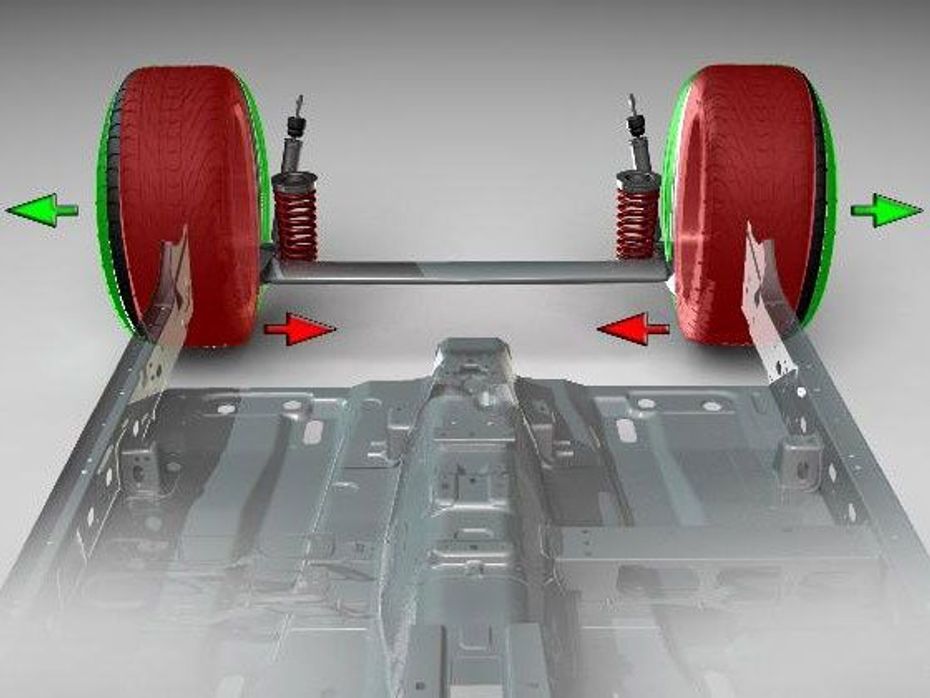
Mahindra BE 6 Launched: Price For The Top-spec Variant Is Out!
- Jan 7, 2025
- Views : 5505

Camber angle is used in the design of the steering and suspension setups of a car. Camber angle is the angle vertical axis of the wheel in relation to the vertical axis of the vehicle when viewed from the front or the back. If the top of the wheel leans away from the engine compared to the bottom of the wheel it is called positive camber. If the bottom of the wheel leans towards the engine compared to the top of the wheel it is called negative camber.

Camber angle alters the handling qualities of a car. Negative camber improves grip while cornering as it places the tyre at a better angle on the road. While cornering a car experiences roll. If the tyre had negative camber the inside of the tyre would try to lift off the ground reducing the contact area of the tyre with the road. Negative camber reduces the chances of the inside of a tyre lifting off thereby aiding handling by increasing the contact area with the road. Negative camber is benefitial for the outside wheel while the inside wheel would benefit most from positive camber.
A car with zero camber would have the largest tyre contact area with the road which would increase straight line speed. The suspension has to be designed in such a way as to have a camber angle which improves the handling traits of a car while having maximum tyre contact patch with the road.

Mahindra BE 6 Launched: Price For The Top-spec Variant Is Out!

JSW MG Motor India Revealed Their New SUV, The MG Majestor At Auto...

Auto Expo 2025: Tata Sierra ICE Concept Breaks Cover, All Details...

VinFast VF3 vs MG Comet EV: A Detailed Comparison Of The Two Cute And...

Budget 2025: More Fuel For Your Auto Dreams?

The Story Of Tata Sierra: An Icon India Missed And Now Eagerly Awaits

Here’s A List Of All Cars That Will Be Coming To The Auto Expo...

2025 Tata Nexon Introduced With 3 New Variants And 2 New Colours

Vayve Eva Vs VinFast VF3: Specifications, Powertrain, And Features...
India's largest automotive community
 Made-In-India Maruti Suzuki Jimny Hits Booking Milestone In Japan - Why Isn’t It As Popular In India?
Made-In-India Maruti Suzuki Jimny Hits Booking Milestone In Japan - Why Isn’t It As Popular In India?
 MG Astor Receives 2025 Model Year Updates, Panoramic Sunroof Becomes More Affordable Now
MG Astor Receives 2025 Model Year Updates, Panoramic Sunroof Becomes More Affordable Now
 Most Affordable Volkswagen EV Coming Soon?
Most Affordable Volkswagen EV Coming Soon?
 Mahindra XEV 9e: Which Variant Gets What? Price And Features Detailed
Mahindra XEV 9e: Which Variant Gets What? Price And Features Detailed
 Rolls-Royce Ghost Series II
Rs. 8.95 Crore
Rolls-Royce Ghost Series II
Rs. 8.95 Crore
 Kia Syros
Rs. 8.99 Lakh
Kia Syros
Rs. 8.99 Lakh
 Vayve Mobility Eva
Rs. 3.25 Lakh
Vayve Mobility Eva
Rs. 3.25 Lakh
 BMW X3
Rs. 75.80 Lakh
BMW X3
Rs. 75.80 Lakh
 Hyundai Creta Electric
Rs. 17.99 Lakh
Hyundai Creta Electric
Rs. 17.99 Lakh